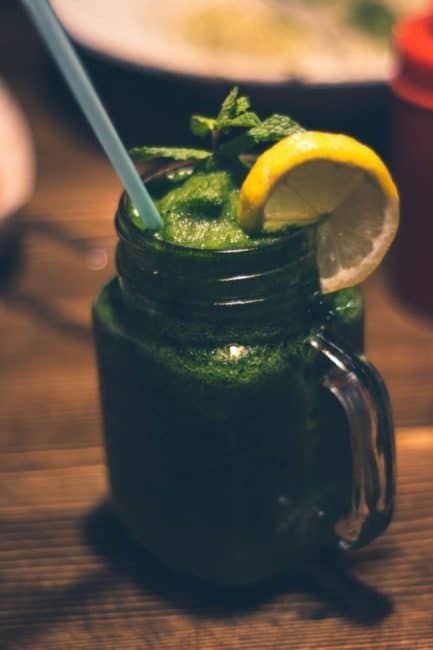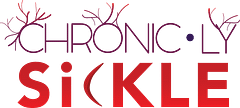
This green smoothie is sweet, simple, and a natural way to help boost your hemoglobin. Chlorophyll is the star of this drink. When used continuously, chlorophyll can help to increase your hemoglobin. From sweet mangoes to fresh spinach, mixed with heart-healthy red cherries and pineapples, this drink is on point. It’s tasty, and takes no more than ten minutes to make. It is also a budget-friendly smoothie, and will make the pickiest of eaters ask for more.

Before, I was introduced to the benefits of Chlorophyll, I had many questions about it. For instance, ‘What is Chlorophyll, exactly?’ I wondered how it would help to support my overall health. I also questioned if its effectiveness could support, and thus increase, my hemoglobin.
The jury is still out: the role of chlorophyll in the Sickle Cell body is a complex one. However, it does seem to offer some benefits that can improve the quality of your life. Chlorophyll is no magical fix, as with anything in life, but chlorophyll is a tool and can be a weapon in your arsenal for treating Sickle Cell Disease.
Chlorophyll is the green pigment that is present in all green plants. The cyanobacteria, also called blue-green algae, are responsible for the absorption of light, which provides energy for the photosynthesis process in plants. Chlorophyll contains magnesium (Mg), whereas the hemoglobin structure is built around iron (Fe), not to be confused with heme (hemoglobin). [1,2]
The reason why incorporating chlorophyll in your diet could be considered beneficial is because chlorophyll and hemoglobin bear a lot of similarities, resulting in the aided production of red blood cells. Both substances play a key role in the handling of oxygen and carbon dioxide. Primarily, we humans consume oxygen and then release carbon dioxide. Plants consume carbon dioxide and release oxygen. Yet, both substances are handled by both organisms.
History & Benefits of Pineapples
Did you know that the scaly bumps on the outside of pineapple are called ‘eyes’?
There is nothing like biting into a juicy Pineapple on a hot day. Pineapples are a sweet tropical fruit popularized in the 17th century. European Settlers first came across this sweet treat in South America. The name ‘pineapple’ derives from its pinecone shape. Pineapples are packed with nutrition, including Vitamins A, B6, Phosphorus, E, K, Iron, Zinc, Vitamin C and Bromelain.4
For centuries, pineapples were so rare that only wealthy individuals could afford them. Royalty and a few rich families used to rent pineapples as a status symbol, to convey opulence and wealth. Wealthy patrons would display pineapples as centerpieces at dinner parties to show off.5 Today, pineapples grow in tropical and sickle cell-prone regions and countries, such as Indonesia and India.
Depending on where you live in the world, there are different types of pineapples. In the U.S, for instance, there are two popular kinds of pineapple. Smooth Cayenne: a cylinder-shaped pineapple, with small spiky leaves. And, the extra sweet variety is also popular. Scientists created that one in a lab in Hawaii.6 Who knew?
Pineapples benefit the body in so many ways. They are very high in vitamin C and bromelain. Both vitamin C and bromelain are wonderful tools to help build the body, offering overwhelming amounts of defense against germs.7 Pineapples work to boost immunities. These minerals are essential to building a healthy immune system, especially because we Warriors may have non-functioning spleens.
In sickle cell disease, the spleen undergoes repeated infarctions, in combination with frequent exposure to low pH and low oxygen tension in the sinusoids and splenic cords.8 When the spleen is enlarged or removed from the body, its function is impaired, causing sickle cell warriors to become more susceptible to infections, germs, and frequent colds.
For many years, pinapples have been used as a health supplement and for medicinal purposes. Bromelain’s medicinal effects include relieving pain, muscle soreness, and other chronic issues.9 Bromelain is great because it can help reduce inflammation in the body caused by misshapen red blood cells.
When inflammation is reduced by eating foods such as pineapples, chronic pain caused by inflammation can somewhat improve. And, when supplements like bromelain are intentionally ingested, the body can reap the benefit in the regeneration of new cells. Sickled cells cause damage and destruction and increase inflammation in the body. I think any natural ways to help mitigate the damage SCD causes is worth investigating.
However, it should be noted that there is no specific scientific evidence to support the usage of bromelain. So it is always important to seek out a medical provider to help you navigate any supplements you might want to add to your regimen.

HOW TO MAKE: A Hemoglobin Boosting Green Smoothie?

To make this yummy green smoothie, all you need is a blender, fruit, and spinach. Don’t forget that the correct ratio of spinach to fruit is up to you. The key to consuming healthy smoothies is making them to taste the way you would want them to taste. So, please feel free to play around with these recipes to adjust to your liking.
INGREDIENTS YOU’LL NEED:
Serving 2
● 1 cup of Fresh Spinach
● ½ cup of Frozen or Fresh Pineapple
● ½ cup of Frozen or Fresh Mango
● ½ cup of Frozen or Fresh Dark Red Cherries
● 2 -3 TBSP of Apple Juice Pressed or Concentrate
● 2 drops of Vegan Chlorophyll Liquid Drops by MaryRuth Liquid

Four Easy Steps to Make Your Smoothie
1. Blend 1 cup of spinach with the 2 drops of Chlorophyll in the blender.
2. Next, add 2 TBSP of Apple Juice Pressed or Concentrate to spinach blend.
3. Toss in the Frozen Fruit or Fresh Fruit ( Pineapple, Mango, Cherries) and blend.
4. Next, add 1 TBSP of Apple Juice Pressed or Concentrate until smooth and creamy.
5. Serve & Enjoy!
*Please consult a healthcare provider whenever you have any medical issues, questions or concerns. I am not liable for any outcomes you might experience. I am not a medical provider.
References
- https://www.differencebetween.com/difference-between-chlorophyll-and-haemoglobin/
- https://www.sciencedirect.com/topics/agricultural-and-biological-sciences/cyanobacteria
- https://www.ncbi.nlm.nih.gov/pmc/articles/PMC6478130/
- https://www.webmd.com/food-recipes/benefits-pineapple
- https://www.history101.com/18th-century-pineapple-status/
- https://www.smithsonianmag.com/arts-culture/its-pineapple-season-but-does-your-fruit-come-from-hawaii-5211854/
- https://www.webmd.com/vitamins/ai/ingredientmono-895/bromelain
- https://www.medscape.com/answers/205926-15298/what-are-the-manifestations-of-sickle-cell-disease-scd-in-the-spleen
- https://www.medscape.com/answers/205926-15298/what-are-the-manifestations-of-sickle-cell-disease-scd-in-the-spleen











Janet Goode Brown
A great article.
I am going to try the green smoothie and thank you for the information. I look forward to reading more about how I can take care of myself and others with sickle-cell. God Bless. Janet Goode-Brown
Chronic•ly Sickle
Thank you for the support! It means a lot! 🙂